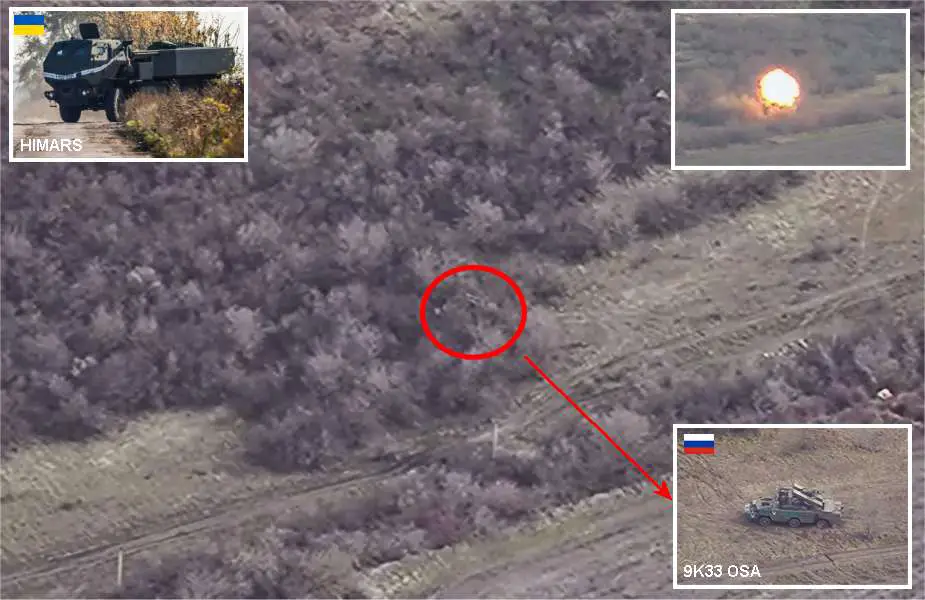Ukrainian Forces Destroy Russian 9K33 OSA Air Defense with Drone-Guided HIMARS Rockets Precision Strike
In a demonstration of tactical prowess and technological superiority, the 73rd Maritime Center of Ukrainian Special Forces utilized the advanced capabilities of the HIMARS (High Mobility Artillery Rocket System), and information provided by a UAV (Unmanned Aerial Vehicle) to destroy a Russian 9K33 OSA. The Ukrainian soldiers during an aerial reconnaissance mission, identified the position of the Russian 9K33 OSA anti-aircraft missile vehicle that was destroyed by the high precision fire of a US-donated HIMARS rocket/missile launcher vehicle.
Follow Army Recognition on Google News at this link

Ukrainian Special Forces use a drone and HIMARS guided rocket to conduct a high-precision strike to destroy Russia's 9K33 OSA air defense missile vehicle. (Picture source Ukrainian Special Forces video footage)
In this critical operation, the deployment of an Unmanned Aerial Vehicle (UAV) played a vital role in the success of the Ukrainian forces. The UAV's contribution went beyond traditional reconnaissance, providing detailed, real-time intelligence crucial for the mission's execution. It offered precise positional data on the 9K33 OSA air defense system, information that was pivotal for the Ukrainian artillery units to accurately calibrate their HIMARS fire. This synergy between aerial surveillance and ground-based artillery proved decisive in the destruction of the target.
The use of drones in modern warfare, especially in the ongoing conflict between Ukrainian and Russian forces, has evolved significantly. Both sides have increasingly relied on these aerial assets for a variety of roles, including surveillance, target acquisition, and damage assessment. Drones offer a significant tactical advantage by providing a real-time overview of the battlefield, identifying enemy positions, and even directing artillery fire.
For instance, Ukrainian artillery units have been using drones to spot enemy targets and guide their fire. These drones, equipped with cameras and sensors, transmit live footage back to the artillery units, enabling them to adjust their aim and fire with greater precision. Similarly, Russian forces have employed drones for reconnaissance and target designation, enhancing the effectiveness of their artillery strikes.
The integration of drone technology with artillery units has transformed the dynamics of battlefield engagements, allowing for more precise and effective operations. This technological advancement has not only increased the accuracy of artillery fire but also reduced the risk of collateral damage by enabling more targeted strikes. The effectiveness of such tactics has been evident in several reported instances where drone-assisted artillery units have successfully engaged and neutralized enemy positions with high accuracy.
The American HIMARS MLRS rocket/missile launcher is renowned for its agility and precision. Capable of firing GPS-guided rockets such as the M31 GMLRS (Guided Multiple Launch Rocket System), it offers a high degree of accuracy in striking targets. The GMLRS rockets, a key component of the HIMARS arsenal, can hit targets up to 70 kilometers away with pinpoint precision. This remarkable range, combined with the system's ability to rapidly deploy and relocate, makes HIMARS a formidable tool in the hands of skilled operators like the Ukrainian forces.
The 9K33 OSA NATO code-named SA-8 GECKO is a Russian air defense system that was designed for short-to-medium range defense against aircraft. Its destruction not only signifies a tactical loss for the Russian forces but also showcases the effective integration of reconnaissance UAVs with the precision striking capability of the HIMARS. This operation highlights the evolving strategies in modern warfare, where accuracy, intelligence, and advanced technology play pivotal roles in achieving victory on the battlefield.
The 9K33 OSA is equipped with six ready-to-fire missiles. These missiles are 9M33 missiles, which are radio command-guided and have a high-explosive fragmentation warhead. They are capable of engaging targets at various altitudes, with effective operational altitudes typically ranging from 50 meters to 12 kilometers.
The 9K33 OSA includes an integrated radar used for both target acquisition and missile guidance. The radar system on the SA-8 Gecko allows it to track and engage multiple aerial targets simultaneously, enhancing its defensive capabilities.
News Russia Ukraine War























